Chapter 3
The Crying
Church
In the spring of 1938, Sun myung Moon graduated from Jeongju Elementary School. It was customary at such events for graduating students to read a short speech of thanks to their teachers. The 8 year old Moon was the last on the rostrum.
"There is something I would like to say," he began. He launched into a criticism of the education system. The assembled guests, who included the police chief, the county magistrate and other district officials, shifted in their seats. Then, to the amazement and embarrassment of the headmaster and staff, he started criticizing the teachers, one by one, analyzing their characters, pointing out the consequences if they were allowed to continue teaching in the way they did, and suggesting that they resolve to change. After finishing with them. he took on the country's leaders and called on them to lead the nation properly. It lasted for a whole hour and the students loved it. The police noted his name. 1
He hoped to attend the Normal School in Pyongyang and become a teacher himself. He studied hard for the entrance exams but was rejected because of color blindness. 2 He decided to go to Seoul, where he enrolled in the electrical engineering department of the Kyongsong Institute of Commerce and Industry, 3 a middle school for boys in the district of Heuksok dong, on the south bank of the Han River.
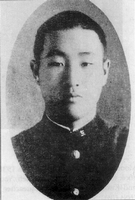 | Moon's middle school protrait (HSA-UWC, Seoul) |
Seoul in the 1930s lay mostly north of the wide, lazy river, but in recent decades has sprawled south. Today the southern area which was once rice paddies, melon groves, and scattered farming villages is home to half of Seoul's ten million people, and over twenty bridges link the two parts of the city. That development began with Heuksok dong an neighboring Sangdo dong and Noryang jin, which had grown up by the first two road and rail bridges that spanned the river. When Moon moved to the area, many Japanese colonial officials and teachers and their families were living in the better houses in Heuksok dong. The street names and signposts were all in Japanese.
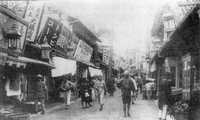 | A Seoul street in the 1920s during the Japanese occupation (Kukusho Kankokai Co., Tokyo) |
The school had been founded in 1934 by its Japanese headmaster, Doi Sanyo. The forty or so teachers were Japanese, except for the gym master, and all classes were in Japanese Doi Sanyo taught perseverance and achievement. "If something doesn't happen, make it happen," he would say. "If you don't have something, do what is necessary to get it." The 1,900 students, like all school children in pre war Japan, were taught to do the work that was expected of them and not waste their breath making excuses for failure.
The boys wore a military style tunic and trousers that came down to just below the knees. The trousers had no side pockets, only back pockets. Gloves were not allowed, so when they were cold, they walked with their hands thrust in their back pockets, in a posture which pushed out their chests in a soldierly fashion.
In his first year, Sun myung Moon lived in three different lodgings. The third was a self catering place he shared with Kwon Duk pal, who had graduated from the school two years earlier and was the young lay preacher at the local church, and a fellow student named Yoo Koo hok. In the second year, his cousin Seung gyun came to study at the school and joined them at the lodgings. Sun myung and Kwon Duk pal shared a room. Each lodger paid twenty two won a month. School fees were five won and food came to about ten won. Their staple diet was rice and soup, and they ate lots of biscuits. Some months, they went without food for one or two days, and when their money arrived from home they treated themselves at a rice cake shop.
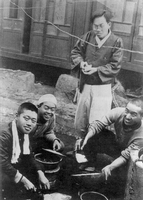 |
| Moon was at school in Seoul from 1938-1941. Moon at right, takes his turn to cook for fellow lodgers. From left, Yoo Koo-bok, Moon's cousin Seung-gyun and Kwon Duk-pal, the lay preacher at the church which Moon attended. (HSA-UWC, Seoul) |
Many of the students in other lodgings were unhappy living at close quarters with people they did not particularly like. Such problems were worst in the lodgings where the students did their own cooking. But the two Moons and their friends got on well, a fact which Seung gyun attributes to a rule introduced by his cousin. They had a pact by which they were forbidden to complain about anyone else's cooking: "Kwon ate in the church and didn't cook at home," said Seung gyun. "Sun myung, Yoo and I took turns in cooking. We cooked in a single pot over a wood fire. The rice was cheap. We had to pick the grit out of it. We made a soup of tofu and sliced onions and red pepper. For side dishes, we would have maybe onions, small fish, and pollack. If the soup was too watery or too salty we had to keep quiet. Yoo and I would slice things up neatly but Sun myung just chucked everything into the pot. We couldn't complain, though.
In the evenings, Sun myung and his friends would sometimes go up the hill behind the village. There they would lie on their backs and gaze at the stars and talk.
Among his peers, a boy's reputation depended largely on how well he could fight. 5 Although he was good at wrestling, Sun myung was in the soccer club 6 In the second year, his cousin Seung gyun bragged to his friends that his "big brother" could easily win the wrestling if he went in for it. 7 He challenged the school wrestling champion, Cho In bok, who was his class president. Cho accepted. Seung gyun tried to persuade Sun myung, who was more reluctant.
"Why should I fight him. He's a kid," Moon said. Cho came up to Sun myung and formally challenged him.
"Do you think you can beat me? Why don't you try?"
"I don't want to fight with you," Sun myung replied.
"Go on You could beat him," urged his cousin, who was eager not to lose face.
"O.K., then " Cho was already in his wrestling shorts. Sun myung was in his school uniform. He took off his small backpack. A crowd gathered. It was to be the best of three throws. The fight began Sun myung won the first throw, then the second and third. Word spread. and he became the unofficial school champion
Every day, Sun myung walked down to the Han river to bathe. There he would see the beggars and poor families who lived on the river bank under the bridge. Often he would cut their hair for them. One summer, his cousin Seung gyun became ill with malaria. Every day for almost two weeks, the fever would break out at around noon.
"Let's go to the river for a swim," Sun myung said one hot day.
"I can't. I've got a fever."
"I know how to cure this," Sun myung announced. He didn't want to go swimming by himself
"Oh?" his cousin asked.
"Yes. It depends on your mental attitude. Come with me and I'll show you," he said. Sun myung led him to the edge of the Han River. "Take your clothes off and get in the water."
Seung gyun tried to resist, but Sun myung insisted and pushed him into the water, and then jumped in himself Seung gyun was shivering when he came out the fever got worse. 8
In the summer and winter vacations when he went home, Moon's family saw that being away in the big city had not dampened his religious fervor. On one visit home, he said grace for the family before a meal and got so absorbed in his prayer that, by the time he had finished, everyone except his brother was asleep. When the villagers sat outside in the summer evenings, they would see him go off to nearby South Hill to pray He was so intense that the village children would come and tell his mother he was wrestling with the trees and the long grass on the hillside
In his first year away from home, he attended services at the Pentecostal church in Heuksok dong. The church was one of six established by the denomination since the arrival of the first American missionary, Mary C. Rumsey, in 1928. 9 It had been set up a few years earlier, when Pak Kyong joon a deacon at the first church in the south west suburb of Sobing go, moved across the river to Heuksok dong. 10 The minister, Pak Song san, held services in Sobing go in the morning and at Heuksok dong in the afternoon. Already in 1936, the congregation which included a growing number of the school students who lodged locally, had moved to a larger room which cost thirty won a month to rent. In 1938, church officers decided they should get a bigger place. As there were no rich members of the congregation, they figured they should get the money from the missionaries. Rev. Pak and six church officers met with two missionaries, one American and one Briton, at the house in downtown Seoul where the missionaries lived. Translating was Henry Dodge Appenzeller, an American who was the director of the Paichai (pronounced Pay chay) School, founded by his father, who had been the first Methodist missionary to Korea.
"We wanted to enlarge the church but we needed money. Our main position was, 'If you don't give us money, we will leave'," said Kim Hee son, one of the young deacons, recalling the meeting forty seven years later 11 The two missionaries, both middle aged women were in a difficult situation. The tradition established by Protestant missions in Korea was to not fund church construction, but to insist that congregations be self supporting. Furthermore, they did not have the money.
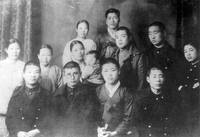 |
| Church group in Seoul. Moon is standing second from right. Elder Kim Hee-son is at the top. Kwak No-pil, who was arrested with Moon as a suspected communist, is seated bottom right. (HSA-UWC, Seoul) |
"OK, go then," the American missionary said. "No, we mustn't break up," the British woman said, dissolving into tears.
In the emotional atmosphere, the Koreans resolved to change denominations. The next question was, which denomination to join, Presbyterian or Methodist or another? Rev. Pak, smarting from the clash with the foreign missionaries, said they should join the new Jesus Church, because it was the first denomination started by Koreans. Few in the congregation knew much about it.
The Jesus Church had formed around the charismatic evangelist Lee Yong do. Lee was born in Hwanghae Province in 1901, the second son of a poor farming family. 12 He was imprisoned in 1919, for two and a half years, for independence activities. As a marked activist. he was unable to graduate from high school. In 1923, an American missionary helped him enter the Union Methodist Seminary in Seoul where he majored in English. After graduation in 1927, he went to Dongchon, Kang won Province. There he rose at four every morning to pray. It was there, his later followers said, that he received the spirit and became a preacher.
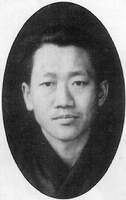 |
| Charasmatic Jesus Church preacher, Lee Yong-do taken in 1932. (Lee Ho-bin) |
When he got inspired, he would sometimes speak for seven or eight hours. If inspiration didn't come, he might not even speak at all. although he had been invited to do so. He earned the pen name 'Shimuon,' meaning 'one who only speaks when words are necessary' On one occasion, it is said, he was praying and saw Satan spiritually. He followed Satan to a believer's house where Satan tried to kill the family members. He confronted Satan and demanded that he leave. Another story described how Lee came across a Christian believer in the countryside who was being attacked by a snake. Lee picked up a stick to kill the snake but it slithered into a pond.
Lee prayed for hours, crying profusely during his prayers. He prayed for the poor and was very generous to beggars. once, some ministers in the northern city of Pyongyang who had invited him to speak were waiting for him at the station. They naturally expected the famous preacher would be a well dressed, commanding figure. When he came off the train, dressed in his usual poor clothes, they did not notice him. Not expecting a welcoming party, he made his own way to the church and prayed there for two or three hours before the ministers found him.
Lee Ho bin, a close friend and a fellow seminary graduate, who later became the leader of the denomination, recalls how Lee's fame spread: "I His sermons were very creative and original. He was very versatile, he was a musician, poet, playwright and preacher. Whenever the YMCA wanted a good revival meeting they would ask him to come because he always attracted many believers from different churches."
Kim Young oon was a Methodist in her home town of Haeju when Lee Yong do came and held revival meetings. "Some elders in the church started to criticize Rev. Lee after members of the congregation stayed in the church and prayed all night and had spiritual experiences, speaking in tongues and going into trances and prophesying. I was one of the ones who stayed all night. The church became divided. Those who were for Lee Yong do began to hold separate meetings which I attended."
Lee Ho bin estimates that by 1932, around thirty churches and six thousand believers considered themselves to be followers of the charismatic preacher. Jealousy of Lee Yong do grew ministers of other churches spread tales that the believers who said they were praying all night were actually holding orgies. These rival clergymen asked the Japanese authorities not to allow Lee to hold his revival services. But the Japanese had no desire to help out the Christian establishment, which they resented because they were protected and supported by foreign missionaries. Ministers openly persuaded their congregations that Lee Yong do's followers were evil, and told them not to greet them even on the street.
In July 1932, Lee was invited by a teacher at the Martha Wilson Women's Bible Institute in the north eastern port of Wonsan to attend morning chapel. 13 The teacher, Baek Nam ju, was also a controversial figure. He and a group of ten believers had for two years been holding services together, rising at four or five in the morning to pray. In the winter, they would walk around barefoot as a form of spiritual training. He taught that the church's interpretation of the second advent of Christ and the destruction of the world in the Last Days was wrong. The Bible, he said, was to be interpreted spiritually and not literally. Faith is to do with heart and life, not ceremony and appearance, he said In December that year, Baek and his group were expelled by their local church for heresy. They continued to hold services, and the group expanded. The Japanese police, thinking it was an independence group, kept a close watch.
At the same time, the pressure was building in the Methodist church against the charismatic Lee Yong do. He was expelled a few months later. He was trans-denominational and did not like the idea of creating another denomination. But without official registration, meetings could not be held. In June, 1933, an official in the Japanese governor-general's office offered to help the expelled ministers get a license to hold services. 14 The Japanese clearly wanted to encourage the development of a church that had no connections to foreign missionaries. The ministers accepted the unexpected offer and decided to call themselves simply the Jesus Church. Lee Yong do was appointed chairman. The core founders were Lee Ho bin and Lee Hwan shin, Yong do's seminary fellows. and Baek Nam ju and Han Joon myung from the Wonsan group. The new church declared its foundation day retroactively to be January 3, 1933. By this time, however, Lee Yong do was ill with Tuberculosis. In October he died, aged thirty two. Lee Ho bin replaced him as chairman .
Within the new church, there was a lot of spiritual activity associated with the Wonsan members, who were led by Baek. For example. someone in the group claimed to have received a revelation that they had to link up with another spiritual group led by a woman on the west coast. Baek is said to have walked the 130 mile journey barefoot to meet her. 15 Later, in the winter of 1934, the new Jesus Church expelled Baek for committing adultery. 16 Although this incident was down played by his friends, it appears to have been linked with rumors of messianic claims. Since the revival which had swept like a bush fire through Korea in 1907, spiritual people had been receiving revelations that the Messiah would come to Korea in the flesh.
One such spiritual woman was Kim Bom joon. She prophesied that Korea was the new Israel and that one day missionaries would go out from Korea to the world. She said that Baek would conceive a child with a virgin, and that the child would be the Messiah. A child was born, but when the news leaked out, the Christian establishment accused Baek of heresy. Kim cried and prayed, "What shall we do Jesus is being crucified again. All is finished." Then she received another revelation telling her that because Baek's mission could not be fulfilled, another child had been prepared and was already born in Pyongyang She prepared to go to Pyongyang, but her family, thinking she was crazy stopped her. 17
The leaders of the Jesus Church denied any messianic role. Such spiritual women were rebuked, but for a few years the intense spirituality that attracted such people persisted. The Jesus Church was born out of persecution and was founded by inspired spiritual leaders. But it lacked clear goals and organization Its leaders were non denominational and moved more according to inspiration than to any plan to expand numbers. The church grew from 1930, though its official founding in 1933, until about 1935. Then its spirituality rapidly declined and it came under increasing oppression from the Japanese authorities. 18
By 1938, the year when Sun myung moved to Seoul, the Jesus Church had thirty two churches in Korea. They were all in the northern half of the country. The only services held in Seoul were in the house of Kang Suk kyong, a wealthy Jesus Church member who had moved from Pyongyang. Occasionally, church leaders and revivalists would hold meetings in her home. They cried and yelled so much during their prayers that neighbors reported them to the police. It was decided that a new church should be established in Heuksok dong, in Seoul. where two of Kang's daughters lived. But there was no money to send a full time minister to the city. It was at this time that the Pentecostal congregation in Heuksok dong came looking for a new church to join. Rev. Pak Song san asked the Jesus Church if it would take his flock from Heuksok dong. They agreed and a new Jesus Church, called the Myongsudae Worship Hall, with some hundred and twenty members, began holding services. Kwon Duk pal, the young lay preacher from the Pentecostal group, was put in charge. He conducted such emotional services that the new church became known locally as 'The Crying Church'
For the last year of his three years at middle school, Sun myung attended this church. During this time, he and his three companions lodged at the home of Lee Kee bong, and briefly at the house of her sister, Lee Kee ha. The two women were the daughters of Mrs. Kang, who had financed the church.
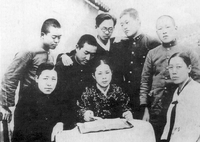 |
| Moon is standing second from the left. Seated right is his lndlady, Lee Kee-bong. (HSA-UWC, Seoul) |
After school every day, Sun myung went to the church to study and pray. He kept the nature of his intense search to himself; but those around him sensed he was different and felt his deep spirituality. A school friend recalled: "He was an exemplary Christian. He would often go to the hills to pray. Lots of Christians did that, but none of them would stay out praying all night as he did." 19
He was given the job of taking Sunday School for the thirty or so children. He taught them the Bible and about God, and occasionally took them on outings. 20 He was popular with the children, who called him Big Mr. Moon and his cousin Little Mr. Moon. Lee Kee bong's nine year old daughter, Im Nam sook, felt he had a special antenna to God and was somewhat in awe of him. One day he grabbed her and twisted her arm behind her back. "Don't call me mister," he said playfully. "Call me your brother." 21
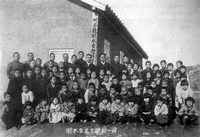 |
| Sunday school group in Seoul. Moon is second from right in the top row of boys. (Pak Kyong-do) |
Often after the services, which were held every Sunday and Wednesday, he would invite some of the church deacons to his room and they would share food and sing and pray and talk late into the night. "Six or seven people would sing and pray," recalled Kim Hee son, the deacon. "We would pray in turn, one after the other. One round would take us to the early morning." On other nights they would sometimes just drop round to share some soup and talk.
The Jesus Church members went into Seoul, and sometimes to the nearby villages, to evangelize. Sometimes when a crowd gathered, the police would come and try to stop Moon from preaching. "What's the crime in witnessing about God?" he would protest.
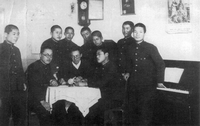 |
| Moon standing below the clock, with fellow students in Bible study group in Seoul. Picture taken February 1940. (Pak Kyong-do) |
One Sunday afternoon in March 1940, he was returning from a service in a new Jesus Church in Sangdo dong, the neighboring ward, with some of the church members, when they came upon a middle aged man lying in the road. The man said he was sick and that he was trying to get back to his home in Pyongtaek, a town forty miles south of Seoul. One of the deacons cut a walking stick for him.
"You need to get to the train station at Noryangjin. It's about a kilometer from here," the deacon said.
"But I don't have any money to buy a ticket," the man said.
"We will carry you to the station, " said Moon. On the way he asked people for money. The ticket cost one won and ten chon. Moon collected two won and fifty chon, bought a ticket and used the rest to buy the man some tea. The man was so moved, he cried.
"You must tell me your address, so I can repay you," he said.
"Don't worry about our address," deacon Kim Hee son said. "Just go to the Jesus Church and believe in Jesus." By the time they returned over the wooded hill to Heuksok dong it was dark.
"When we help people like that, we feel a deep satisfaction, even though we missed our meal," Moon remarked.